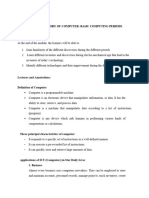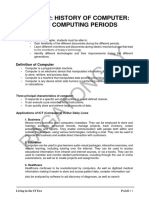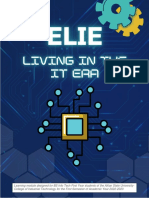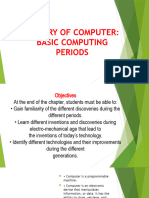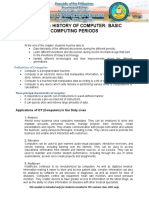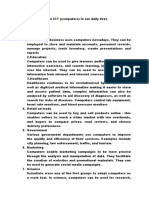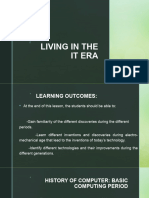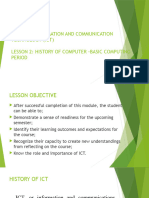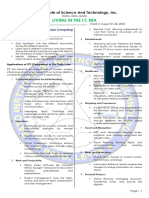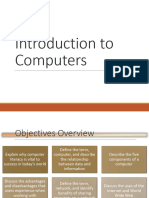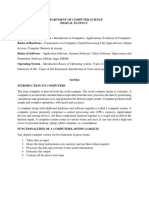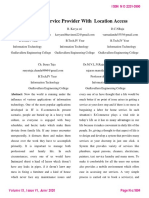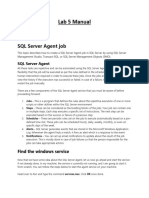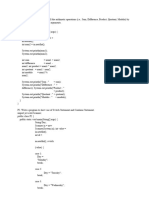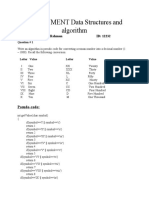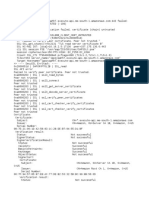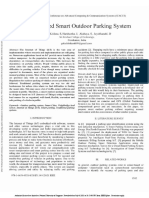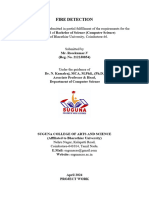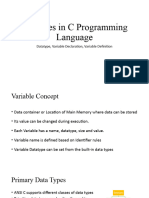GEE3 Module2
Uploaded by
Jonathan PagaGEE3 Module2
Uploaded by
Jonathan PagaRepublic of the Philippines
PARTIDO STATE UNIVERSITY
Camarines Sur
Module No.: 2
History of Computer: Basic Computing Periods
Student: _____________________
Course Code: GEE3 Week/Period: 1 & 2
Course Title: Living in the IT era` Name of Faculty: Jonathan B. Paga
I. Introduction
The rapid evolution of technology is very visible in this era. It appears to be moving faster than
ever before. The evolution of technology from year to year is one of astounding promise and
opportunity—as well as uncertainty. Basically, technology has always existed, and as long as people
exist, information technology will exist as well, because there were always ways of communicating
through technology available at the time. Although the future is unknown, technological advancement
continues to reshape our world in ways that encourage people to form new habits, find new ways to
collaborate, and become better human beings. And, in most cases, these changes result in a slew of new
opportunities and disruptions in every industry.
II. Learning Objectives:
1. Gain familiarity of the different discoveries during the different periods.
2. Learn different inventions and discoveries during electro-mechanical age that lead to the
inventions of today’s technology
3. Identify the different technologies and their improvements during the different generations.
III. Lesson/Topics:
1. Definition f Computer
2. Three principal characteristics of computer
3. Applications of ICT (Computer) in Our Daily Lives
4. History of Computer: Basic Computing Periods
5. Basic Computing Periods – Ages
6. History of Computer: Generations of Computer
Definition of Computer
• Computer is a programmable machine.
• Computer is an electronic device that manipulates information, or data. It has the ability to
store, retrieve, and process data.
• Computer is a machine that manipulates data according to a list of instructions (program).
• Computer is any device which aids humans in performing various kinds of computations or
calculations.
Module 2: History of Computer: Basic Computing Periods/Page 1 of 20
Republic of the Philippines
PARTIDO STATE UNIVERSITY
Camarines Sur
Three principal characteristics of computer:
• It responds to a specific set of instructions in a well-defined manner.
• It can execute a pre-recorded list of instructions.
• It can quickly store and retrieve large amounts of data.
Applications of ICT (Computers) in Our Daily Lives
1. Business
Almost every business uses computers nowadays. They can be employed to store and maintain
accounts, personnel records, manage projects, track inventory, create presentations and
reports. They enable communication with people both within and outside the business, using
various technologies, including e-mail. They can be used to promote the business and enable
direct interaction with customers.
2. Education
Computers can be used to give learners audio-visual packages, interactive exercises, and remote
learning, including tutoring over the internet. They can be used to access educational
information from intranet and internet sources, or via e-books. They can be used to maintain
and monitor student performance, including through the use of online examinations, as well as
to create projects and assignments.
3. Healthcare
Healthcare continues to be revolutionized by computers. As well as digitized medical
information making it easier to store and access patient data, complex information can also be
analyzed by software to aid discovery of diagnoses, as well as search for risks of diseases.
Computers control lab equipment, heart rate monitors, and blood pressure monitors. They
enable doctors to have greater access to information on the latest drugs, as well as the ability to
share information on diseases with other medical specialists.
4. Retail and Trade
Computers can be used to buy and sell products online - this enables sellers to reach a wider
market with low overheads, and buyers to compare prices, read reviews, and choose delivery
preferences. They can be used for direct trading and advertising too, using sites such as eBay,
Craigslist, or local listings on social media or independent websites.
5. Government
Various government departments use computers to improve the quality and efficiency of their
services. Examples include city planning, law enforcement, traffic, and tourism. Computers can
Module 2: History of Computer: Basic Computing Periods/Page 2 of 20
Republic of the Philippines
PARTIDO STATE UNIVERSITY
Camarines Sur
be used to store information, promote services, communicate internally and externally, as well
as for routine administrative purposes.
6. Marketing
Computers enable marketing campaigns to be more precise through the analysis and
manipulation of data. They facilitate the creation of websites and promotional materials. They
can be used to generate social media campaigns. They enable direct communication with
customers through email and online chat.
7. Science
Scientists were one of the first groups to adopt computers as a work tool. In science, computers
can be used for research, sharing information with other specialists both locally and
internationally, as well as collecting, categorizing, analyzing, and storing data. Computers also
play a vital role in launching, controlling, and maintaining space craft, as well as operating other
advanced technology.
8. Publishing
Computers can be used to design pretty much any type of publication. These might include
newsletters, marketing materials, fashion magazines, novels, or newspapers. Computers are
used in the publishing of both hard-copy and e-books. They are also used to market publications
and track sales.
9. Arts and Entertainment
Computers are now used in virtually every branch of the arts, as well as in the wider
entertainment industry. Computers can be used to create drawings, graphic designs, and
paintings. They can be used to edit, copy, send, and print photographs. They can be used by
writers to create and edit. They can be used to make, record, edit, play, and listen to music.
They can be used to capture, edit and watch videos. They can be used for playing games.
10. Communication
Computers have made real-time communication over the internet easy, thanks to software and
videoconferencing services such as Skype. Families can connect with audio and video,
businesses can hold meetings between remote participants, and news organizations can
interview people without the need for a film crew. Modern computers usually have
microphones and webcams built-in nowadays to facilitate software like Skype. Older
communications technologies such as email are also still used widely.
11. Banking and Finance
Most banking in advanced countries now takes place online. You can use computers to check
your account balance, transfer money, or pay off credit cards. You can also use computer
Module 2: History of Computer: Basic Computing Periods/Page 3 of 20
Republic of the Philippines
PARTIDO STATE UNIVERSITY
Camarines Sur
technology to access information on stock markets, trade stocks, and manage investments.
Banks store customer account data, as well as detailed information on customer behavior which
is used to streamline marketing.
12. Transport
Road vehicles, trains, planes, and boats are increasingly automated with computers being used
to maintain safety and navigation systems, and increasingly to drive, fly, or steer. They can also
highlight problems that require attention, such as low fuel levels, oil changes, or a failing
mechanical part. Computers can be used to customize settings for individuals, for example, seat
setup, air-conditioning temperatures.
13. Navigation
Navigation has become increasingly computerized, especially since computer technology has
been combined with GPS technology. Computers combined with satellites mean that it's now
easy to pinpoint your exact location, know which way that you are moving on a map, and have a
good idea of amenities and places of interest around you.
14. Working From Home
Computers have made working from home and other forms of remote working increasingly
common. Workers can access necessary data, communicate, and share information without
commuting to a traditional office. Managers are able to monitor workers' productivity remotely.
15. Military
Computers are used extensively by the military. They are used for training purposes. They are
used for analyzing intelligence data. They are used to control smart technology, such as guided
missiles and drones, as well as for tracking incoming missiles and destroying them. They work
with other technologies such as satellites to provide geospatial information and analysis. They
aid communications. They help tanks and planes to target enemy forces.
16. Social and Romance
Computers have opened up many ways of socializing that didn't previously exist. Social media
enables people to chat in text or audio in real time across large distances, as well as exchange
photographs, videos, and memes. Dating sites and apps help people to find romance. Online
groups help people to connect with others who have similar interests. Blogs enable people to
post a variety of views, updates, and experiences. Online forums enable discussions between
people on specialist or general topics.
17. Booking Vacations
Module 2: History of Computer: Basic Computing Periods/Page 4 of 20
Republic of the Philippines
PARTIDO STATE UNIVERSITY
Camarines Sur
Computers can be used by travelers to study timetables, examine route options, and buy plane,
train, or bus tickets. They can be used to explore and book accommodation, whether traditional
hotels, or through newer services, such as Air BnB. Guided tours, excursions, events, and trips
can also be explored and booked online using computers.
18. Security and Surveillance
Computers are increasingly being combined with other technologies to monitor people and
goods. Computers combined with biometric passports make it harder for people to fraudulently
enter a country or gain access to a passenger airplane. Face-recognition technology makes it
easier to identify terrorists or criminals in public places. Driver plates can be auto scanned by
speed cameras or police cars. Private security systems have also become much more
sophisticated with the introduction of computer technology and internet technology.
19. Weather Forecasting
The world's weather is complex and depends upon a multitude of factors that are constantly
changing. It's impossible for human beings to monitor and process all the information coming in
from satellite and other technologies, never mind perform the complex calculations that are
needed to predict what is likely to happen in the future. Computers can process the large
amounts of meteorological information.
20. Robotics
Robotics is an expanding area of technology which combines computers with science and
engineering to produce machines that can either replace humans, or do specific jobs that
humans are unable to do. One of the first use of robotics was in manufacturing to build cars.
Since then, robots have been developed to explore areas where conditions are too harsh for
humans, to help law enforcement, to help the military, and to assist healthcare professionals.
History of Computer: Basic Computing Periods
Earliest Computers originally calculations were computed by humans, whose job title was computers.
• These human computers were typically engaged in the calculation of a mathematical
expression.
• The calculations of this period were specialized and expensive, requiring years of training in
mathematics.
• The first use of the word "computer" was recorded in 1613, referring to a person who carried
out calculations, or computations, and the word continued to be used in that sense until the
middle of the 20th century.
Module 2: History of Computer: Basic Computing Periods/Page 5 of 20
Republic of the Philippines
PARTIDO STATE UNIVERSITY
Camarines Sur
a) Tally sticks
A tally stick was an ancient memory aid device to record and document numbers, quantities, or
even messages.
b) Abacus
An abacus is a mechanical device used to aid an individual in performing mathematical
calculations.
o The abacus was invented in Babylonia in 2400 B.C.
o The abacus in the form we are most familiar with was first used in China in
around 500 B.C.
o It used to perform basic arithmetic operations.
c) Napier’s Bones
o Invented by John Napier in 1614.
o Allowed the operator to multiply, divide and calculate square and cube roots by moving the
rods around and placing them in specially constructed boards.
Module 2: History of Computer: Basic Computing Periods/Page 6 of 20
Republic of the Philippines
PARTIDO STATE UNIVERSITY
Camarines Sur
d) Slide Rule
Invented by William Oughtred in 1622.
o Is based on Napier's ideas about logarithms.
o Used primarily for – multiplication – division – roots – logarithms – Trigonometry
o Not normally used for addition or subtraction.
e) Pascaline
o Invented by Blaise Pascal in 1642.
o It was its limitation to addition and subtraction.
o It is too expensive.
Module 2: History of Computer: Basic Computing Periods/Page 7 of 20
Republic of the Philippines
PARTIDO STATE UNIVERSITY
Camarines Sur
f) Stepped Reckoner
o Invented by Gottfried Wilhelm Leibniz in 1672.
o The machine that can add, subtract, multiply and divide automatically.
g) Jacquard Loom
o The Jacquard loom is a mechanical loom, invented by Joseph-Marie Jacquard in 1881.
o It is an automatic loom controlled by punched cards.
Module 2: History of Computer: Basic Computing Periods/Page 8 of 20
Republic of the Philippines
PARTIDO STATE UNIVERSITY
Camarines Sur
h) Arithmometer
o A mechanical calculator invented by Thomas de Colmar in 1820,
o The first reliable, useful and commercially successful calculating machine.
o The machine could perform the four basic mathematic functions.
o The first mass-produced calculating machine.
i) Difference Engine and Analytical Engine
o It an automatic, mechanical calculator designed to tabulate polynomial functions.
o Invented by Charles Babbage in 1822 and 1834
o It is the first mechanical computer.
Module 2: History of Computer: Basic Computing Periods/Page 9 of 20
Republic of the Philippines
PARTIDO STATE UNIVERSITY
Camarines Sur
j) First Computer Programmer
o In 1840, Augusta Ada Byron suggests to Babbage that he use the binary system.
o She writes programs for the Analytical Engine.
k) Scheutzian Calculation Engine
o Invented by Per Georg Scheutz in 1843.
o Based on Charles Babbage's difference engine.
Module 2: History of Computer: Basic Computing Periods/Page 10 of 20
Republic of the Philippines
PARTIDO STATE UNIVERSITY
Camarines Sur
o The first printing calculator.
l) Tabulating Machine
o Invented by Herman Hollerith in 1890.
o To assist in summarizing information and accounting.
m) Harvard Mark 1
o Also known as IBM Automatic Sequence Controlled Calculator (ASCC).
o Invented by Howard H. Aiken in 1943
o The first electro-mechanical computer.
Module 2: History of Computer: Basic Computing Periods/Page 11 of 20
Republic of the Philippines
PARTIDO STATE UNIVERSITY
Camarines Sur
n) Z1
o The first programmable computer.
o Created by Konrad Zuse in Germany from 1936 to 1938.
o To program the Z1 required that the user insert punch tape into a punch tape reader and all
output was also generated through punch tape.
o) Atanasoff-Berry Computer (ABC)
o It was the first electronic digital computing device.
o Invented by Professor John Atanasoff and graduate student Clifford Berry at Iowa State
University between 1939 and 1942.
Module 2: History of Computer: Basic Computing Periods/Page 12 of 20
Republic of the Philippines
PARTIDO STATE UNIVERSITY
Camarines Sur
p) ENIAC
o ENIAC stands for Electronic Numerical Integrator and Computer.
o It was the first electronic general-purpose computer.
o Completed in 1946.
o Developed by John Presper Eckert and John Mauchly.
Module 2: History of Computer: Basic Computing Periods/Page 13 of 20
Republic of the Philippines
PARTIDO STATE UNIVERSITY
Camarines Sur
q) UNIVAC 1
o The UNIVAC I (UNIVersal Automatic Computer 1) was the first commercial computer.
o Designed by John Presper Eckert and John Mauchly.
r) EDVAC
o EDVAC stands for Electronic Discrete Variable Automatic Computer
o The First Stored Program Computer
o Designed by Von Neumann in 1952.
o It has a memory to hold both a stored program as well as data.
Module 2: History of Computer: Basic Computing Periods/Page 14 of 20
Republic of the Philippines
PARTIDO STATE UNIVERSITY
Camarines Sur
s) The First Portable Computer
o Osborne 1 – the first portable computer.
o Released in 1981 by the Osborne Computer Corporation.
t) The First Computer Company
o The first computer company was the Electronic Controls Company.
o Founded in 1949 by John Presper Eckert and John Mauchly.
Basic Computing Periods - Ages
a. Premechanical
The premechanical age is the earliest age of information technology. It can be defined as the
time between 3000B.C. and 1450A.D. We are talking about a long time ago. When humans first started
communicating they would try to use language or simple picture drawings known as petroglyths which
were usually carved in rock. Early alphabets were developed such as the Phoenician alphabet.
Module 2: History of Computer: Basic Computing Periods/Page 15 of 20
Republic of the Philippines
PARTIDO STATE UNIVERSITY
Camarines Sur
As alphabets became more popular and more people were writing information down, pens and
paper began to be developed. It started off as just marks in wet clay, but later paper was created out of
papyrus plant. The most popular kind of paper made was probably by the Chinese who made paper
from rags. Now that people were writing a lot of information down, they needed ways to keep it all in
NCES permanent storage. This is where the first books and libraries are developed. You’ve probably
heard of Egyptian scrolls which were popular ways of writing down information to save. Some groups of
people were actually binding paper together into a book-like form.
Also, during this period were the first numbering systems. Around 100A.D. was when the first 1-
9 system was created by people from India. However, it wasn’t until 875A.D. (775 years later) that the
number 0 was invented. And yes, now that numbers were created, people wanted stuff to do with
them, so they created calculators. A calculator was the very first sign of an information processor. The
popular model of that time was the abacus.
b. Mechanical
The mechanical age is when we first start to see connections between our current technology
and its ancestors. The mechanical age can be defined as the time between 1450 and 1840. A lot of new
technologies are developed in this era as there is a large explosion in interest with this area.
Technologies like the slide rule (an analog computer used for multiplying and dividing) were invented.
Blaise Pascal invented the Pascaline which was a very popular mechanical computer. Charles Babbage
developed the difference engine which tabulated polynomial equations using the method of finite
differences.
There were lots of different machines created during this era and while we have not yet gotten
to a machine that can do more than one type of calculation in one, like our modern-day calculators, we
Module 2: History of Computer: Basic Computing Periods/Page 16 of 20
Republic of the Philippines
PARTIDO STATE UNIVERSITY
Camarines Sur
are still learning about how all of our all-in-one machines started. Also, if you look at the size of the
machines invented in this time compared to the power behind them it seems (to us) absolutely
ridiculous to understand why anybody would want to use them, but to the people living in that time ALL
of these inventions were HUGE.
c. Electromechanical
Now we are finally getting close to some technologies that resemble our modern-day
technology. The electromechanical age can be defined as the time between 1840 and 1940. These are
the beginnings of telecommunication. The telegraph was created in the early 1800s. Morse code was
created by Samuel Morse in 1835. The telephone (one of the most popular forms of communication
ever) was created by Alexander Graham Bell in 1876. The first radio developed by Guglielmo Marconi in
1894. All of these were extremely crucial emerging technologies that led to big advances in the
information technology field. The first large-scale automatic digital computer in the United States was
the Mark 1 created by Harvard University around 1940. This computer was 8ft high, 50ft long, 2ft wide,
and weighed 5 tons - HUGE. It was programmed using punch cards. How does your PC match up to this
hunk of metal? It was from huge machines like this that people began to look at downsizing all the parts
to first make them usable by businesses and eventually in your own home.
Module 2: History of Computer: Basic Computing Periods/Page 17 of 20
Republic of the Philippines
PARTIDO STATE UNIVERSITY
Camarines Sur
d. Electronic
The electronic age is what we currently live in. It can be defined as the time between 1940 and
right now. The ENIAC was the first high-speed, digital computer capable of being reprogrammed to solve
a full range of computing problems. This computer was designed to be used by the U.S. Army for
artillery firing tables. This machine was even bigger than the Mark 1 taking up 680 square feet and
weighing 30 tons - HUGE. It mainly used vacuum tubes to do its calculations.
There are 4 main sections of digital computing.
o The first was the era of vacuum tubes and punch cards like the ENIAC and Mark 1.
Rotating magnetic drums were used for internal storage.
o The second generation replaced vacuum tubes with transistors, punch cards were
replaced with magnetic tape, and rotating magnetic drums were replaced by magnetic
cores for internal storage. Also during this time high-level programming languages were
created such as FORTRAN and COBOL.
o The third generation replaced transistors with integrated circuits, magnetic tape was
used throughout all computers, and magnetic core turned into metal oxide
semiconductors. An actual operating system showed up around this time along with the
advanced programming language BASIC.
o The fourth and latest generation brought in CPUs (central processing units) which
contained memory, logic, and control circuits all on a single chip. The personal computer
was developed (Apple II). The graphical user interface (GUI) was developed.
Module 2: History of Computer: Basic Computing Periods/Page 18 of 20
Republic of the Philippines
PARTIDO STATE UNIVERSITY
Camarines Sur
History of Computer: Generations of Computer
There are five generations of computer:
• First generation – 1946 to 1958
• Second generation – 1959 to 1964
• Third generation – 1965 to 1970
• Fourth generation – 1971 to Today
• Fifth generation – Today to future
a. The First Generation
The first computers used vacuum tubes for circuitry and magnetic drums for memory, and were often
enormous, taking up entire rooms. They were very expensive to operate and in addition to using a great
deal of electricity, generated a lot of heat, which was often the cause of malfunctions. First generation
computers relied on machine language, the lowest-level programming language understood by
computers, to perform operations, and they could only solve one problem at a time. Input was based on
punched cards and paper tape, and output was displayed on printouts.
b. The Second Generation
Transistors replaced vacuum tubes and ushered in the second generation of computers. One transistor
replaced the equivalent of 40 vacuum tubes. Allowing computers to become smaller, faster, cheaper,
more energy-efficient and more reliable. Still generated a great deal of heat that can damage the
computer. Second-generation computers moved from cryptic binary machine language to symbolic, or
assembly, languages, which allowed programmers to specify instructions in words. Secondgeneration
computers still relied on punched cards for input and printouts for output. These were also the first
computers that stored their instructions in their memory, which moved from a magnetic drum to
magnetic core technology.
Examples: UNIVAC III, RCA 501, Philco Transact S-2000, NCR 300 series, IBM 7030 Stretch, IBM
7070, 7080, 7090 series
c. The Third Generation
The development of the integrated circuit was the hallmark of the third generation of computers.
Transistors were miniaturized and placed on silicon chips, called semiconductors, which drastically
increased the speed and efficiency of computers. It could carry out instructions in billionths of a second.
Much smaller and cheaper compare to the second-generation computers.
d. The Fourth Generation
The microprocessor brought the fourth generation of computers, as thousands of integrated circuits
were built onto a single silicon chip. As these small computers became more powerful, they could be
Module 2: History of Computer: Basic Computing Periods/Page 19 of 20
Republic of the Philippines
PARTIDO STATE UNIVERSITY
Camarines Sur
linked together to form networks, which eventually led to the development of the Internet. Fourth
generation computers also saw the development of GUIs, the mouse and handheld devices.
e. The Fifth Generation
Based on Artificial Intelligence (AI). Still in development. The use of parallel processing and
superconductors is helping to make artificial intelligence a reality. The goal is to develop devices that
respond to natural language input and are capable of learning and self-organization. There are some
applications, such as voice recognition, that are being used today.
IV. Learning Activities:
Instruction: (must be in a word document format)
1. Give at least one (1) example device/s that represents the each generation of computers.
Note: follow the naming format of a file. (e.g. jonathanpaga_module 2_Activity
V. Assessment Tasks:
- To follow through google forms/quiz in Moodle LMS.
VI. References/Learning Resources:
• https://ftms.edu.my/v2/wp-content/uploads/2019/02/csca0201_ch01.pdf
• https://www.sutori.com/story/history-of-ict-information-and-communications-technology--
N7J51bQqSU7vLWcVfdn5M9qa
• https://www.livescience.com/20718-computer-history.html
• https://www.explainthatstuff.com/historyofcomputers.html
Prepared by: Reviewed by: Approved:
JONATHAN B. PAGA, MIT EMY S. LASARTE, EdD ARNEL B. MILLESCA, EdD, JD
FACULTY PROGRAM DIRECTOR CAMPUS DEAN
Module 2: History of Computer: Basic Computing Periods/Page 20 of 20
You might also like
- Living in The It Era Module 2 History of Computer Basic Computing Periods FinalNo ratings yetLiving in The It Era Module 2 History of Computer Basic Computing Periods Final14 pages
- Module 2: History of Computer: Basic Computing Periods Objectives100% (1)Module 2: History of Computer: Basic Computing Periods Objectives9 pages
- Module 2 History of Computer - Basic Computing PeriodsNo ratings yetModule 2 History of Computer - Basic Computing Periods16 pages
- Living in The It Era: History of Computer: Basic Computing Periods100% (1)Living in The It Era: History of Computer: Basic Computing Periods49 pages
- Lesson 2 (2) .PPTX - 20240910 - 110131 - 0000No ratings yetLesson 2 (2) .PPTX - 20240910 - 110131 - 000023 pages
- Erica Andres BSA-2 1.what Is A Computer?No ratings yetErica Andres BSA-2 1.what Is A Computer?6 pages
- Discovering Computers 2011: Living in A Digital WorldNo ratings yetDiscovering Computers 2011: Living in A Digital World36 pages
- Course Assessment: - Class Participation: 10% - Test /Assignment/IT Quiz: 10%No ratings yetCourse Assessment: - Class Participation: 10% - Test /Assignment/IT Quiz: 10%33 pages
- UNIT 2-History-of-Computer-Basic-Computing-PeriodNo ratings yetUNIT 2-History-of-Computer-Basic-Computing-Period3 pages
- Computer: History of Computer: Basic Computing PeriodsNo ratings yetComputer: History of Computer: Basic Computing Periods7 pages
- 02 History of Computer-Basic Computing PeriodsNo ratings yet02 History of Computer-Basic Computing Periods24 pages
- GEE3C - w8-9 Information, Control and PrivacyNo ratings yetGEE3C - w8-9 Information, Control and Privacy82 pages
- Intelligent Service Provider With Location Access: Alochana Chakra Journal ISSN NO:2231-3990No ratings yetIntelligent Service Provider With Location Access: Alochana Chakra Journal ISSN NO:2231-39907 pages
- WhatsUp Gold 14.3 Distributed Getting Started GuideNo ratings yetWhatsUp Gold 14.3 Distributed Getting Started Guide6 pages
- Santosh Goud - Senior AWS Big Data EngineerNo ratings yetSantosh Goud - Senior AWS Big Data Engineer9 pages
- An Introduction and Active Directory Basics - Q & ANo ratings yetAn Introduction and Active Directory Basics - Q & A7 pages
- Employee Management System PresentationNo ratings yetEmployee Management System Presentation14 pages
- Program To Implement The Bisection Method: Anshul SiwachNo ratings yetProgram To Implement The Bisection Method: Anshul Siwach49 pages
- ACM ICPC Report March 1 1 - Competencias en Jamaica100% (1)ACM ICPC Report March 1 1 - Competencias en Jamaica5 pages

